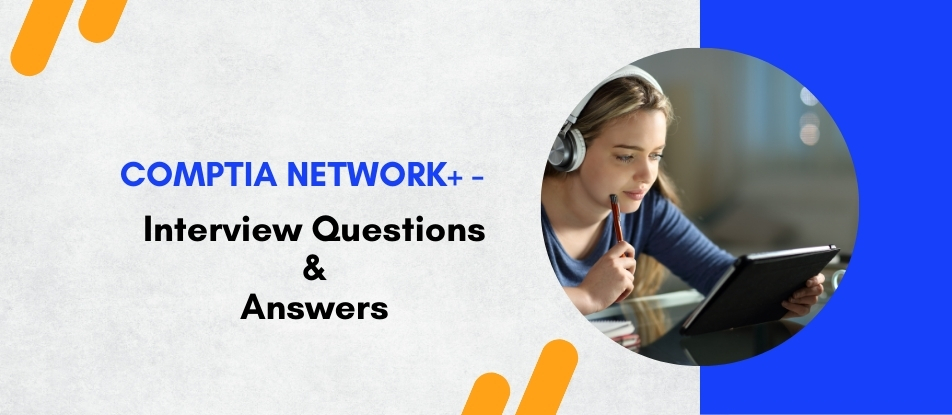
The CompTIA Network+ training course equips learners with essential networking skills and knowledge. It covers key topics such as network design, configuration, management, and troubleshooting, focusing on both wired and wireless networks. Students will also learn about network security, standards, and protocols. Ideal for IT professionals, this course prepares candidates for the CompTIA Network+ certification exam, validating their ability to manage and secure network infrastructures effectively.
CompTIA Network+ Interview Question Answers - For Intermediate
1. What is packet switching, and how does it work?
Packet switching is a method of grouping data that is transmitted over a digital network into packets. Networks route these packets individually, and then they are reassembled at their destination. This method is efficient because it allows for a dynamic path that can adapt to network congestion, ensuring reliable data transmission.
2. Describe the function of a repeater and where it might be used in a network.
A repeater is a network device used to regenerate or replicate signals that are weakened or lost due to long distance or interference. It's used in networks to extend the transmission distance between two devices, ensuring the signal can cover longer distances without degradation.
3. What are the different types of cables used in networking, and what scenarios are each used for?
Common types of networking cables include twisted pair (e.g., Cat5e, Cat6), coaxial, and fiber optic. Twisted pair cables are used for most LANs. Coaxial cables are often used for broadband internet connections. Fiber optic cables are used for high-speed, high-fidelity data transmission over long distances.
4. Explain the difference between a managed and an unmanaged switch.
A managed switch allows for greater control over network traffic and management of features such as VLANs, network monitoring, and QoS. An unmanaged switch works out of the box but doesn't allow for any customization or monitoring, suitable for simple connectivity tasks.
5. What is a network bridge, and how does it differ from a router?
A network bridge connects multiple network segments at the data link layer (Layer 2) of the OSI model, allowing them to act as a single network. A router operates at the network layer (Layer 3) and is used to connect multiple networks and route traffic between them based on IP addresses.
6. Can you explain the concept of port forwarding?
Port forwarding is a network operation that directs external traffic coming into a network to a specific internal IP address and port. It's commonly used to allow external devices to access services provided by devices inside a private local area network (LAN).
7. What is a DMZ in networking, and why is it used?
A DMZ (Demilitarized Zone) in networking refers to a physical or logical subnetwork that contains and exposes an organization's external-facing services to a larger, untrusted network, typically the internet. It adds an additional layer of security to the network's LAN; an external attacker only has access to equipment in the DMZ, rather than any other part of the network.
8. How does SSL/TLS work to secure a connection?
SSL/TLS (Secure Sockets Layer/Transport Layer Security) is a protocol that provides a secure channel between two machines operating over the internet or an internal network. It uses encryption to ensure that data transmitted is secure and remains confidential. SSL/TLS typically uses a combination of public-key and symmetric-key encryption to secure a connection between two parties.
9. What is the purpose of a subnet, and how is subnetting beneficial?
Subnetting divides a network into smaller, manageable pieces, or subnets. It improves network performance and speed by reducing broadcast traffic. Additionally, subnetting enhances security by isolating sections of the network and can also efficiently utilize IP addresses by allocating them based on actual need rather than a one-size-fits-all approach.
10. What are the common reasons for network failures, and how can they be prevented?
Common reasons include hardware failures, software bugs, configuration errors, overloaded systems, and external attacks. Prevention strategies involve regular maintenance, updating and patching systems, thorough testing of configurations, capacity planning, and implementing robust security measures.
11. How do you set up a basic firewall rule to block or allow specific traffic?
Setting up a basic firewall rule involves specifying the direction (inbound or outbound), the action (allow or block), the protocol (TCP, UDP), the port number, and the source or destination IP addresses. For example, to block incoming HTTP traffic, you would block inbound connections on TCP port 80.
12. What is the role of ICMP in networking?
ICMP (Internet Control Message Protocol) is used in IP networks to send error messages and operational information indicating, for example, that a requested service is not available or that a host or router could not be reached. ICMP is used by network devices, like routers, to send error messages and operational information indicating the status of a request.
13. Explain the principle of load balancing and its benefits in a network.
Load balancing distributes network or application traffic across multiple servers, preventing any single server from becoming a bottleneck, thus improving the responsiveness and availability of applications or websites. Benefits include increased reliability through redundancy, better resource utilization, and improved overall performance.
14. What is network latency, and what factors can affect it?
Network latency is the time it takes for data to travel from its source to its destination across a network. Factors affecting latency include the physical distance the data must travel, the quality of the transmission medium, the number of hops between the source and destination, and the speed of the routers and switches the data traverses.
15. How do you troubleshoot a DNS resolution problem?
Troubleshooting DNS resolution can involve checking the local host file for incorrect entries, using commands like ping and nslookup to test DNS response, ensuring the DNS servers are reachable and configured correctly, and checking the network configuration to ensure the correct DNS servers are specified.
16. What is a network protocol analyzer, and how is it used?
A network protocol analyzer, also known as a packet sniffer, is a tool used to capture, analyze, and decode network traffic. It's used for network troubleshooting, analysis, software and protocol development, and education.
17. Describe how encryption protects data in transit.
Encryption converts data into a coded format during transmission, making it unreadable to anyone except those possessing the correct decryption key. This ensures that even if the data is intercepted, it remains confidential and secure against unauthorized access.
18. What steps would you take to secure a wireless network?
Steps include changing the default administrator password, using WPA3 encryption, disabling WPS, hiding the network SSID, filtering MAC addresses, reducing the range of the signal, and regularly updating the router's firmware.
19. Can you explain what a routing table is and its importance in networking?
A routing table is a data table stored in a router that lists the routes to particular network destinations. It's crucial because it provides the information necessary for a router to forward packets to their correct destinations via the best path possible.
20. What is the function of the traceroute command, and how can it be useful?
The traceroute command is used to identify the path taken by packets across an IP network from source to destination. It's useful for diagnosing the location of failures or bottlenecks in the network path, understanding routing paths, and measuring transit delays of packets.
CompTIA Network+ Interview Question Answers - For Advanced
1. Explain the process and importance of subnetting in network design.
Subnetting is a method used to divide a larger network into smaller, more manageable sub-networks or subnets. This process is crucial for improving network performance and security. By creating subnets, network traffic can be isolated, reducing congestion and the risk of collisions. Subnetting also enhances security by segregating different departments or functions within an organization. The process involves borrowing bits from the host portion of an IP address to create a subnet mask. This new mask allows the creation of multiple smaller networks within the original address space, optimizing the utilization of IP addresses and facilitating efficient routing.
2. What are VLANs, and how do they enhance network security and performance?
VLANs (Virtual Local Area Networks) are logical subdivisions of a physical network that group together devices from different physical locations as if they were on the same LAN. VLANs enhance network security by isolating sensitive data and restricting access to authorized users only. They also improve network performance by reducing broadcast domains, which minimizes unnecessary traffic and collisions. VLANs are implemented using network switches, and they can be configured based on various criteria such as function, team, or application, allowing for greater flexibility and control over network traffic and security.
3. Describe the concept of Quality of Service (QoS) in networking and its significance.
Quality of Service (QoS) refers to the ability of a network to prioritize certain types of traffic to ensure optimal performance for critical applications and services. QoS is significant because it manages bandwidth and reduces latency, jitter, and packet loss, ensuring that high-priority services like VoIP, video conferencing, and online gaming receive the necessary resources to function effectively. QoS is implemented through various techniques such as traffic shaping, resource reservation, and prioritization, which help maintain the desired level of performance for key applications while balancing the overall network load.
4. What is the difference between stateful and stateless firewalls, and when should each be used?
Stateful firewalls monitor the state of active connections and make decisions based on the context of the traffic, such as the state of the connection and the session information. They provide a higher level of security by allowing only legitimate packets that match an active connection to pass through. Stateless firewalls, on the other hand, filter packets based solely on predefined rules such as IP addresses and ports, without considering the state of the connection. Stateful firewalls are best suited for environments where tracking and maintaining the state of network connections is crucial for security, while stateless firewalls are suitable for simpler, high-speed environments where performance is a priority.
5. Explain the purpose and function of Network Address Translation (NAT).
Network Address Translation (NAT) is a technique used to modify network address information in IP packet headers while they are in transit across a router. The primary purpose of NAT is to improve security and reduce the number of IP addresses an organization needs. NAT allows multiple devices on a private network to share a single public IP address for accessing the internet. This not only conserves IP addresses but also hides the internal network structure from external entities, providing an additional layer of security. NAT can be implemented in different forms, including static NAT, dynamic NAT, and Port Address Translation (PAT), each serving specific use cases.
6. Describe the differences between TCP and UDP, and provide examples of applications that use each protocol.
TCP (Transmission Control Protocol) is a connection-oriented protocol that ensures reliable data transmission by establishing a connection and using error-checking mechanisms to guarantee that data is delivered accurately and in the correct order. Applications like web browsing (HTTP/HTTPS), email (SMTP/IMAP/POP3), and file transfer (FTP) use TCP due to its reliability.
UDP (User Datagram Protocol) is a connectionless protocol that provides faster data transmission by sending packets without establishing a connection or performing error-checking. This makes UDP suitable for applications where speed is more critical than reliability, such as online gaming, video streaming, and VoIP. Because UDP does not guarantee delivery, it is often used in scenarios where occasional data loss is acceptable or where the application can handle retransmissions at the application layer.
7. What are the benefits and challenges of implementing IPv6 in an existing IPv4 network?
The implementation of IPv6 in an existing IPv4 network offers several benefits, including a vastly larger address space, improved routing efficiency, and enhanced security features like IPsec, which is mandatory in IPv6. IPv6 also supports auto-configuration and eliminates the need for NAT, simplifying network management.
However, there are challenges associated with the transition. These include the need for dual-stack configurations to support both IPv4 and IPv6 during the transition period, potential compatibility issues with legacy systems, and the requirement for staff training to manage and troubleshoot IPv6 networks. Additionally, network infrastructure, including routers and switches, must be capable of supporting IPv6, which may involve hardware and software upgrades.
8. How does Dynamic Host Configuration Protocol (DHCP) work, and what are its advantages?
Dynamic Host Configuration Protocol (DHCP) automates the process of assigning IP addresses and other network configuration parameters to devices on a network. When a device connects to a network, it sends a DHCPDISCOVER message to locate a DHCP server. The server responds with a DHCPOFFER message, providing an available IP address. The device then sends a DHCPREQUEST message to accept the offer, and the server responds with a DHCPACK message, finalizing the assignment.
The advantages of DHCP include simplified network administration, as it eliminates the need for manual IP address configuration, reduces the risk of address conflicts, and allows for centralized management of IP addresses. DHCP also supports the dynamic allocation of IP addresses, enabling efficient use of available address space and facilitating the easy addition or removal of devices from the network.
9. Explain the concept of a DMZ (Demilitarized Zone) in network security.
A DMZ (Demilitarized Zone) is a network segment that separates an internal local area network (LAN) from untrusted external networks, typically the internet. The DMZ adds an additional layer of security by isolating sensitive internal systems from external threats while allowing access to public-facing services like web servers, email servers, and DNS servers. The primary function of a DMZ is to act as a buffer zone, reducing the risk of external attacks reaching the internal network. Firewalls are used to control traffic between the internal network, the DMZ, and external networks, ensuring that only legitimate traffic is allowed to pass through.
10. What is MPLS (Multiprotocol Label Switching), and how does it improve network efficiency and performance?
Multiprotocol Label Switching (MPLS) is a data-carrying technique that assigns labels to data packets, enabling routers to make forwarding decisions based on the label information rather than traditional IP routing tables. MPLS improves network efficiency by allowing for the creation of predetermined, highly efficient paths for data traffic, reducing latency and improving overall performance. It also supports Quality of Service (QoS), ensuring that high-priority traffic receives the necessary resources to maintain optimal performance. MPLS is commonly used in large-scale enterprise networks and service provider networks to enhance the reliability, scalability, and manageability of data transport across various types of underlying network technologies.
Course Schedule
| Apr, 2025 | Weekdays | Mon-Fri | Enquire Now |
| Weekend | Sat-Sun | Enquire Now | |
| May, 2025 | Weekdays | Mon-Fri | Enquire Now |
| Weekend | Sat-Sun | Enquire Now |
Related Courses
Related Articles
Related Interview
Related FAQ's
- Instructor-led Live Online Interactive Training
- Project Based Customized Learning
- Fast Track Training Program
- Self-paced learning
- In one-on-one training, you have the flexibility to choose the days, timings, and duration according to your preferences.
- We create a personalized training calendar based on your chosen schedule.
- Complete Live Online Interactive Training of the Course
- After Training Recorded Videos
- Session-wise Learning Material and notes for lifetime
- Practical & Assignments exercises
- Global Course Completion Certificate
- 24x7 after Training Support












 Join our Live Instructor-Led online classes delivered by industry experts
Join our Live Instructor-Led online classes delivered by industry experts